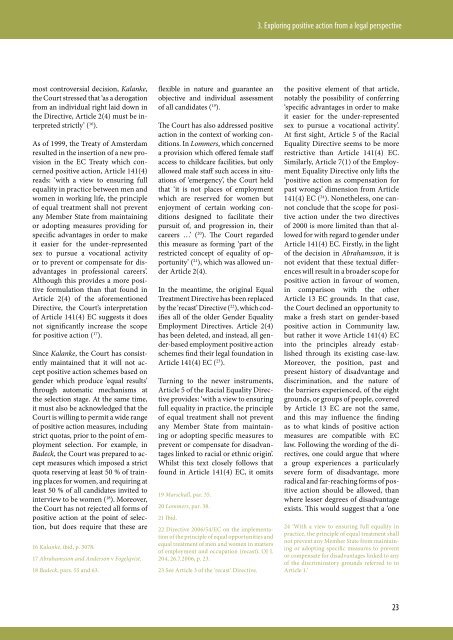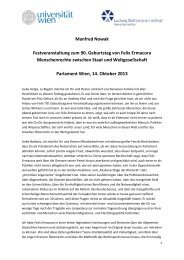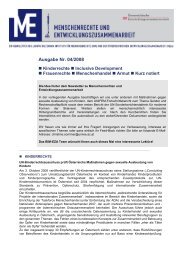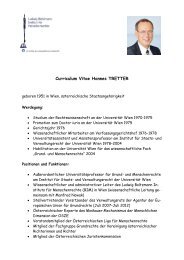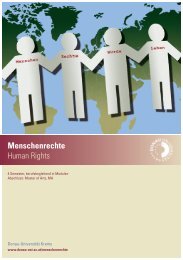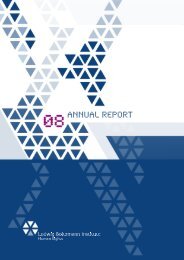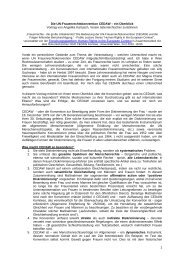International perspectives on positive action measures - European ...
International perspectives on positive action measures - European ...
International perspectives on positive action measures - European ...
Create successful ePaper yourself
Turn your PDF publications into a flip-book with our unique Google optimized e-Paper software.
most c<strong>on</strong>troversial decisi<strong>on</strong>, Kalanke,<br />
the Court stressed that ‘as a derogati<strong>on</strong><br />
from an individual right laid down in<br />
the Directive, Article 2(4) must be interpreted<br />
strictly’ ( 16 ).<br />
As of 1999, the Treaty of Amsterdam<br />
resulted in the inserti<strong>on</strong> of a new provisi<strong>on</strong><br />
in the EC Treaty which c<strong>on</strong>cerned<br />
<strong>positive</strong> acti<strong>on</strong>, Article 141(4)<br />
reads: ‘with a view to ensuring full<br />
equality in practice between men and<br />
women in working life, the principle<br />
of equal treatment shall not prevent<br />
any Member State from maintaining<br />
or adopting <strong>measures</strong> providing for<br />
specific advantages in order to make<br />
it easier for the under-represented<br />
sex to pursue a vocati<strong>on</strong>al activity<br />
or to prevent or compensate for disadvantages<br />
in professi<strong>on</strong>al careers’.<br />
Although this provides a more <strong>positive</strong><br />
formulati<strong>on</strong> than that found in<br />
Article 2(4) of the aforementi<strong>on</strong>ed<br />
Directive, the Court’s interpretati<strong>on</strong><br />
of Article 141(4) EC suggests it does<br />
not significantly increase the scope<br />
for <strong>positive</strong> acti<strong>on</strong> ( 17 ).<br />
Since Kalanke, the Court has c<strong>on</strong>sistently<br />
maintained that it will not accept<br />
<strong>positive</strong> acti<strong>on</strong> schemes based <strong>on</strong><br />
gender which produce ‘equal results’<br />
through automatic mechanisms at<br />
the selecti<strong>on</strong> stage. At the same time,<br />
it must also be acknowledged that the<br />
Court is willing to permit a wide range<br />
of <strong>positive</strong> acti<strong>on</strong> <strong>measures</strong>, including<br />
strict quotas, prior to the point of employment<br />
selecti<strong>on</strong>. For example, in<br />
Badeck, the Court was prepared to accept<br />
<strong>measures</strong> which imposed a strict<br />
quota reserving at least 50 % of training<br />
places for women, and requiring at<br />
least 50 % of all candidates invited to<br />
interview to be women ( 18 ). Moreover,<br />
the Court has not rejected all forms of<br />
<strong>positive</strong> acti<strong>on</strong> at the point of selecti<strong>on</strong>,<br />
but does require that these are<br />
16 Kalanke, ibid, p. 3078.<br />
17 Abrahamss<strong>on</strong> and Anders<strong>on</strong> v Fogelqvist.<br />
18 Badeck, pars. 55 and 63.<br />
<str<strong>on</strong>g>Internati<strong>on</strong>al</str<strong>on</strong>g> <str<strong>on</strong>g>perspectives</str<strong>on</strong>g> <strong>on</strong> <strong>positive</strong> acti<strong>on</strong> <strong>measures</strong> 3. 1. Exploring Introducti<strong>on</strong>: <strong>positive</strong> New acti<strong>on</strong> Business from Horiz<strong>on</strong>s a legal perspective<br />
in Europe<br />
flexible in nature and guarantee an<br />
objective and individual assessment<br />
of all candidates ( 19 ).<br />
The Court has also addressed <strong>positive</strong><br />
acti<strong>on</strong> in the c<strong>on</strong>text of working c<strong>on</strong>diti<strong>on</strong>s.<br />
In Lommers, which c<strong>on</strong>cerned<br />
a provisi<strong>on</strong> which offered female staff<br />
access to childcare facilities, but <strong>on</strong>ly<br />
allowed male staff such access in situati<strong>on</strong>s<br />
of ‘emergency’, the Court held<br />
that ‘it is not places of employment<br />
which are reserved for women but<br />
enjoyment of certain working c<strong>on</strong>diti<strong>on</strong>s<br />
designed to facilitate their<br />
pursuit of, and progressi<strong>on</strong> in, their<br />
careers …’ ( 20 ). The Court regarded<br />
this measure as forming ‘part of the<br />
restricted c<strong>on</strong>cept of equality of opportunity’<br />
( 21 ), which was allowed under<br />
Article 2(4).<br />
In the meantime, the original Equal<br />
Treatment Directive has been replaced<br />
by the ‘recast’ Directive ( 22 ), which codifies<br />
all of the older Gender Equality<br />
Employment Directives. Article 2(4)<br />
has been deleted, and instead, all gender-based<br />
employment <strong>positive</strong> acti<strong>on</strong><br />
schemes find their legal foundati<strong>on</strong> in<br />
Article 141(4) EC ( 23 ).<br />
Turning to the newer instruments,<br />
Article 5 of the Racial Equality Directive<br />
provides: ‘with a view to ensuring<br />
full equality in practice, the principle<br />
of equal treatment shall not prevent<br />
any Member State from maintaining<br />
or adopting specific <strong>measures</strong> to<br />
prevent or compensate for disadvantages<br />
linked to racial or ethnic origin’.<br />
Whilst this text closely follows that<br />
found in Article 141(4) EC, it omits<br />
19 Marschall, par. 35.<br />
20 Lommers, par. 38.<br />
21 Ibid.<br />
22 Directive 2006/54/EC <strong>on</strong> the implementati<strong>on</strong><br />
of the principle of equal opportunities and<br />
equal treatment of men and women in matters<br />
of employment and occupati<strong>on</strong> (recast), OJ L<br />
204, 26.7.2006, p. 23.<br />
23 See Article 3 of the ‘recast’ Directive.<br />
the <strong>positive</strong> element of that article,<br />
notably the possibility of c<strong>on</strong>ferring<br />
‘specific advantages in order to make<br />
it easier for the under-represented<br />
sex to pursue a vocati<strong>on</strong>al activity’.<br />
At first sight, Article 5 of the Racial<br />
Equality Directive seems to be more<br />
restrictive than Article 141(4) EC.<br />
Similarly, Article 7(1) of the Employment<br />
Equality Directive <strong>on</strong>ly lifts the<br />
‘<strong>positive</strong> acti<strong>on</strong> as compensati<strong>on</strong> for<br />
past wr<strong>on</strong>gs’ dimensi<strong>on</strong> from Article<br />
141(4) EC ( 24 ). N<strong>on</strong>etheless, <strong>on</strong>e cannot<br />
c<strong>on</strong>clude that the scope for <strong>positive</strong><br />
acti<strong>on</strong> under the two directives<br />
of 2000 is more limited than that allowed<br />
for with regard to gender under<br />
Article 141(4) EC. Firstly, in the light<br />
of the decisi<strong>on</strong> in Abrahamss<strong>on</strong>, it is<br />
not evident that these textual differences<br />
will result in a broader scope for<br />
<strong>positive</strong> acti<strong>on</strong> in favour of women,<br />
in comparis<strong>on</strong> with the other<br />
Article 13 EC grounds. In that case,<br />
the Court declined an opportunity to<br />
make a fresh start <strong>on</strong> gender-based<br />
<strong>positive</strong> acti<strong>on</strong> in Community law,<br />
but rather it wove Article 141(4) EC<br />
into the principles already established<br />
through its existing case-law.<br />
Moreover, the positi<strong>on</strong>, past and<br />
present history of disadvantage and<br />
discriminati<strong>on</strong>, and the nature of<br />
the barriers experienced, of the eight<br />
grounds, or groups of people, covered<br />
by Article 13 EC are not the same,<br />
and this may influence the finding<br />
as to what kinds of <strong>positive</strong> acti<strong>on</strong><br />
<strong>measures</strong> are compatible with EC<br />
law. Following the wording of the directives,<br />
<strong>on</strong>e could argue that where<br />
a group experiences a particularly<br />
severe form of disadvantage, more<br />
radical and far-reaching forms of <strong>positive</strong><br />
acti<strong>on</strong> should be allowed, than<br />
where lesser degrees of disadvantage<br />
exists. This would suggest that a ‘<strong>on</strong>e<br />
24 ‘With a view to ensuring full equality in<br />
practice, the principle of equal treatment shall<br />
not prevent any Member State from maintaining<br />
or adopting specific <strong>measures</strong> to prevent<br />
or compensate for disadvantages linked to any<br />
of the discriminatory grounds referred to in<br />
Article 1.’<br />
23


